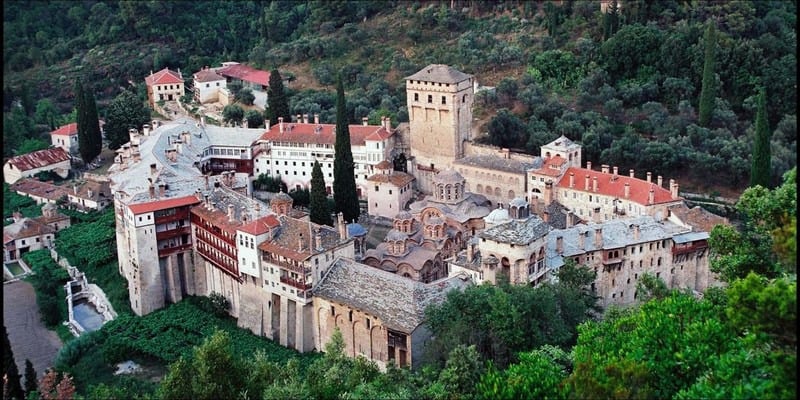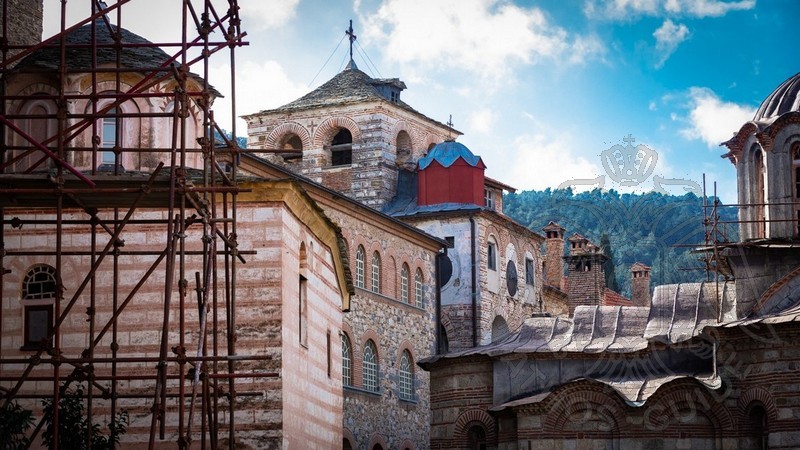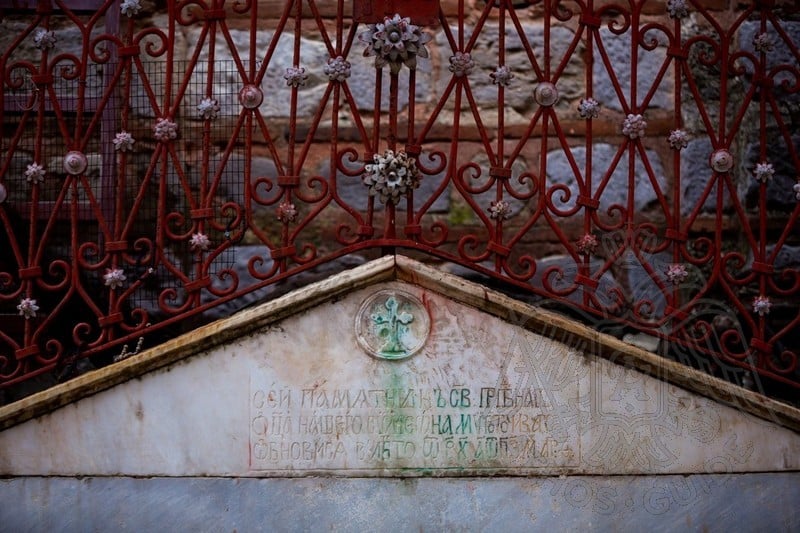The miraculous vine of Saint Simeon the Myrrh-flowing grows in the Holy Monastery of Hilandar on Mount Athos. Near the walls of the monastery's Katholikon, there is the empty tomb of the Saint. That’s where the vine rises, full of fruit and beauty. As long as it bears grapes, the monks feel the grace of Saint Simeon dwelling among them.
The grapes from the vineyard are dried and distributed to all those in need. They have great power and help especially childless couples. Orthodox Christians address their prayers to the saint asking for:
- deliverance from infertility and help in childbearing,
- strengthening of health,
- finding the true path and enlightening people’s souls,
- healing from every kind of illness, both physical and mental,
- strengthening of faith,
- guidance on the path of truth,
- achieving material prosperity,
- achievement of spiritual balance.
Saint Simeon of Myrrh is one of the most beloved saints of our church. All of the orthodox world praises and worships him for his grace. He stands out in many ways and has a special place in the hearts of all believers. Many events of his life, the fate that determined his course, his spiritual strength, the sacred heritage he handed down to us, are outstanding examples of faith and divine grace. We could even say that he is one of the most important models in the history of our Church.
The saint united the principalities of Serbia, which were under foreign rule, and revived Orthodoxy in the country. Moreover, he was the inspiration for a whole series of saints who learned from him and followed his example. Having fulfilled his mission, he put on monasticism and retired from the world, choosing to live an ascetic life.
 After the death of Saint Simeon, a great miracle happened in the Holy Monastery of Hilandar, that highlighted his holiness. His remains began to gush myrrh. This is the reason why we glorify him with the nickname "the Myrrh-flowing". The incorruption of relics in our Church is a fairly widespread phenomenon. However, the effusion of myrrh is much rarer and usually manifests itself only once or periodically over long periods of time. Thus, the myrrh that emerged from the relics of the Saint proved, precisely, how righteous and blessed he was. His holiness is also confirmed by the fact that he was the sole founder of a dynasty from which so many saints arose. That is why it was named by the Serbian history as "The Holy Vine of Nemanjić", after the saint's secular name, Nemanja.
After the death of Saint Simeon, a great miracle happened in the Holy Monastery of Hilandar, that highlighted his holiness. His remains began to gush myrrh. This is the reason why we glorify him with the nickname "the Myrrh-flowing". The incorruption of relics in our Church is a fairly widespread phenomenon. However, the effusion of myrrh is much rarer and usually manifests itself only once or periodically over long periods of time. Thus, the myrrh that emerged from the relics of the Saint proved, precisely, how righteous and blessed he was. His holiness is also confirmed by the fact that he was the sole founder of a dynasty from which so many saints arose. That is why it was named by the Serbian history as "The Holy Vine of Nemanjić", after the saint's secular name, Nemanja.
The vineyard at the monastery is also characterized as "Holy". This is not a mere poetic designation. It is a real miracle experienced by all the faithful who come to the monastery. After all, the vine was planted by Saint Simeon himself. For many centuries, people who eat its fruit have been cured of infertility and every disease.
As already mentioned, Saint Simeon received such a great grace from God that he became himself the progenitor of many saints and defenders of Orthodoxy. No one in the Church of Christ has ever been honored and miraculously rewarded as much as Saint Simeon.
As it appears from his biography, which was recorded by the monk Dominian of the Holy Monastery of Hilandar, "from his youth he desired to serve God in holiness and truth, to stand before Him all the days of his life".
Stephen Nemanja was born around 1113 in Ribnica, Zeta, where he was baptized as a Christian. In his biography it is particularly noted the following fact. Having been baptized at an early age through a Catholic ceremony, he grew up believing that this baptism was completely invalid. Allowing no compromise between true Christianity and other cults, he was rebaptized by the Orthodox ceremony.
In the thirty-seventh year of his reign, Stephen Nemanja, determined to continue his life with discretion and divine enlightenment, decided to become a monk.
 On the 25th of March 1195, on the day of the Annunciation of the Blessed Mary, Stephen entered the monastery of Studenitsa, which he had founded himself. There he took the name Simeon. His wife Anna, ruler of the whole Serbian land, also became a nun with the name Anastasia and retired to the monastery of the Holy Virgin in Ras.
On the 25th of March 1195, on the day of the Annunciation of the Blessed Mary, Stephen entered the monastery of Studenitsa, which he had founded himself. There he took the name Simeon. His wife Anna, ruler of the whole Serbian land, also became a nun with the name Anastasia and retired to the monastery of the Holy Virgin in Ras.
After a short time, having accepted the invitations of his son Sava, Saint Simeon went to Mount Athos. On October 8, 1197 he arrived at the monastery. The monks who were living there received him with great joy and honor. Initially, Simeon stopped at the Holy and Great Monastery of Vatopedi. There, as Saint Sava used to say, he found his "missed" self.
After spending some time in Vatopedi, blessed Simeon begged his friend, the Greek King Alexios, to grant him a place to build a new monastery on Athos. Thus, the construction of the Holy Monastery of Hilandar began. The monastery had existed since the 5th century. However, over time it had suffered much damage. Father and son reconstructed the buildings of the monastery, bringing back its prosperity and strength.
Saint Simeon died on the 13th of February 1200, at the age of 86. Because of his great virtues, the Lord honored the blessed Saint with the gift of miracles. His body began to gush myrrh, and by the power of the Divine Grace many miracles began to take place.
Initially, the Saint was buried in the grounds of the Holy Monastery of Hilandar. After a few years, his son Sava decided to return his remains to Serbia. He was convinced that they should be placed in his homeland, for which his father had done so much.
The monks of Mount Athos were initially very saddened that they had lost the saint's holy relics. They themselves considered their presence in the monastery a great grace and blessing. However, the monk Simeon appeared in the dream of the abbot of the monastery telling him that his relic should be returned back home and comfort his brothers in Serbia. However, he would leave a miraculous vine for the sake of the monks. While it would bring fruit, his blessing would be scattered in the monastery.
This prophecy was fulfilled in 1207. A vine began to sprout from the stone wall of the saint's empty tomb. It grew to the height of one and a half meters from the ground. Athonite tradition says that as long as the vine bears fruit, the blessing of the Saint rests among the mountains of Athos.
Nonetheless, this is not the only reason that makes the vine such an important heritage. The holy fathers quickly began to notice that pilgrims who tasted the fruit of the vine managed to have children, even if they had not previously tasted the happiness of parenthood. Since then and to this day, the monks have distributed to all the faithful dried grapes of the miraculous vine. They even send small packages by the post, in order to support any person in need.
The relics, returned to Saint Simeon's homeland, continued to gush myrrh. The showcase containing them is still today in Serbia. It heals and comforts pilgrims, who often anoint themselves with the myrrh, asking for the affection and care of this great Saint.
